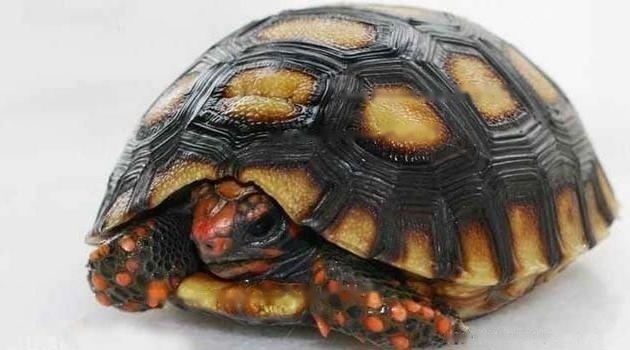The red-footed tortoise is the genus of the tortoise family and the oldest reptile. It is very popular in northern South America. Welcome, mostly in Brazil, Venezuela, Paraguay, Caribbean islands and Ecuador. Compared to most tortoises in the Americas, the red-footed tortoise is of medium size. Their heads and limbs have red scales, which are particularly obvious, so they are named red-legged tortoises. Red-legged tortoises like to eat grass and succulents, or dead animals, and more often live in wet forests or savannahs.

The red-legged tortoise has a large, yellow head, orange-red limbs and tail, a dark brown shell, and a pale yellow center. The scales on the legs are sharp and dark red. At the same time, there are cherry red or bright orange markings and spots on the legs. The southern species red-legged tortoises have swollen bulbous flesh around their nostrils. Red-footed tortoises are usually only 40 to 50 centimeters in size, and males are slightly larger than females. The male's additional indentation is lower than that of the other tortoises, and the carapace is flatter and more pronounced hourglass-shaped. When the tortoise shell is larger than 30 centimeters, the hollow in the middle will appear as a dumbbell, but this is only part of the situation.
The climate of South America where the red-footed tortoise lives is relatively stable, and the climate is relatively stable for one year. The four seasons do not change much, so they usually do not enter a dormant state, and they are constantly active, especially after three o'clock in the afternoon, their activity frequency is very high. Although they don't sleep, they spend half their time basking and resting, and they're not always in motion. They don't move much when they are resting, and some turtles even stay in the same place for a month. Their moving speed is also very slow, usually only about four meters in an hour, but if there is a place where they need to accelerate, they will raise their legs, and even move hundreds of meters in an hour, the difference is really big of. And they move mostly under dense vegetation.
Red-footed tortoises like to bask in the sun, which they can absorb from ultraviolet light Converted to vitamin B, of course, all tortoises have this characteristic. For the red-legged tortoise, the daily sunshine time is less, usually 15 minutes. And they bask in the sun near shelter to avoid hyperthermia. In addition, red-legged tortoises will also pile up their food in the shape of spider webs, in the area of 0.6 to 100 hectares, so that their food will be better 's hidden. But because of their obvious nature, they can easily become prey to other animals. Animals like raccoons and lizards prey on red-legged tortoises, and even meerkats and mice attack their nests and eggs. But their carapace can provide them with temporary shelter and can play a role in protecting life.
If you want to raise red-legged tortoises, the first thing to consider is Arrange a suitable turtle box for them. Wooden turtle boxes are fine, don't worry about them getting moldy because of the water. In fact, the best humidity for red-legged tortoises will not exceed 80%, and the wood will only become moldy after being soaked in water. . The soil used for the bottom of the box is preferably planted, because they are more interested in crawling objects, so even if some turtle species are aggressive, they can be mixed together. Then you also need to consider the comfort of the environment. Red-legged tortoises live in forests and require higher humidity than other tortoises, so you can put a water basin in which the red-legged tortoises can enter when feeding. , and pay attention to the amount of water at all times, because they themselves will drink the water inside. The temperature of raising red-legged tortoises can be higher, and the minimum temperature should be kept in the range of ten degrees. You can use day and night lights or electric blankets. Give them plenty of bathing opportunities to ensure that the red-footed tortoise has a healthy physique.
The red-footed tortoise is an omnivorous animal and likes to eat grass and succulents. Or dead animals, most of them live in wet forests or savannahs. In the process of family farming, they can choose eggs, lean meat, moistened canned dog food, fruits, vegetables, etc. as their food. Vegetables need to account for 85%, including radishes, beets, mustard greens, spinach, celery, beans, lentils, long beans, corn, sweet potatoes, celery, rose petals, etc. Fruits should account for 10%, including apples, pears, pineapples, cherries, papayas, grapes, mangoes, cherries, bananas, nectarines, mulberries, figs, tomatoes and so on. High-concentration animal protein should be less than 5%, and terrapin feeds such as sardines fish and ground beef can also be provided. For hard-boiled eggs, try to peel off the eggshell to avoid scratching the stomach. Inject cabbage, cabbage or Chinese cabbage and other vegetables with more water, including papaya and other fruits, try not to feed them, and eat them easily. They are inedible such as rice noodles, and rotten fruit will make them sick.
![[Dog Training 5] The training method of pet dog dining etiquette](/static/img/12192/12192_1.jpg)




